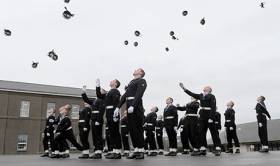Displaying items by tag: Recruit Class 'Sweeney'
Naval Service Recruit Class 'Sweeney' Passing Out
#Recuits - The Naval Service Recruit Class 'Sweeney' commenced training in October 2015. A passing out parade today will mark the culmination of their training and successful entry into the Naval Service at the rank of Ordinary Seaman.
In total the 39 recruits are drawn from 14 different counties, 2 of whom are originally from the UK. They range in age from 18 to 27 and have completed numerous modules during their 5 months extensive training, including weapons training, foot drill, arms drill, navigational training, medical training and of course seamanship. Special awards will be given for Best Shot, Best Kit and Best Recruit.
The class is named 'Sweeney' after Ted Sweeney, the Irish Coast Guardsman and Blacksod lighthouse keeper who on June 3, 1944 delivered a weather forecast by telephone from Co Mayo’s most westerly point. The report convinced General Dwight D Eisenhower to delay the D-Day invasion for 24 hours, potentially averting a military disaster and changing the course of WW2. Classes are named in honour of significant people in maritime history. Ted Sweeney’s son Edward will be present on the day and a presentation will be made. Edward Sweeney will be accompanied by his wife Rita.
Recruit Class Sweeney raised €6,050 from a rowathon in aid of the Baby Lexie O’Riordan Foundation. Lexie O’Riordan & her parents Sylvia & Ed will be present on the day and the cheque will be presented. Members of the class were also involved as models for the Brave Men Walking charity event, in aid of the Irish Cancer Society and Breakthrough Cancer Research. They also participated in the Christmas fun run on the Naval Base in aid of Build for Life Cystic Fibrosis.





























































